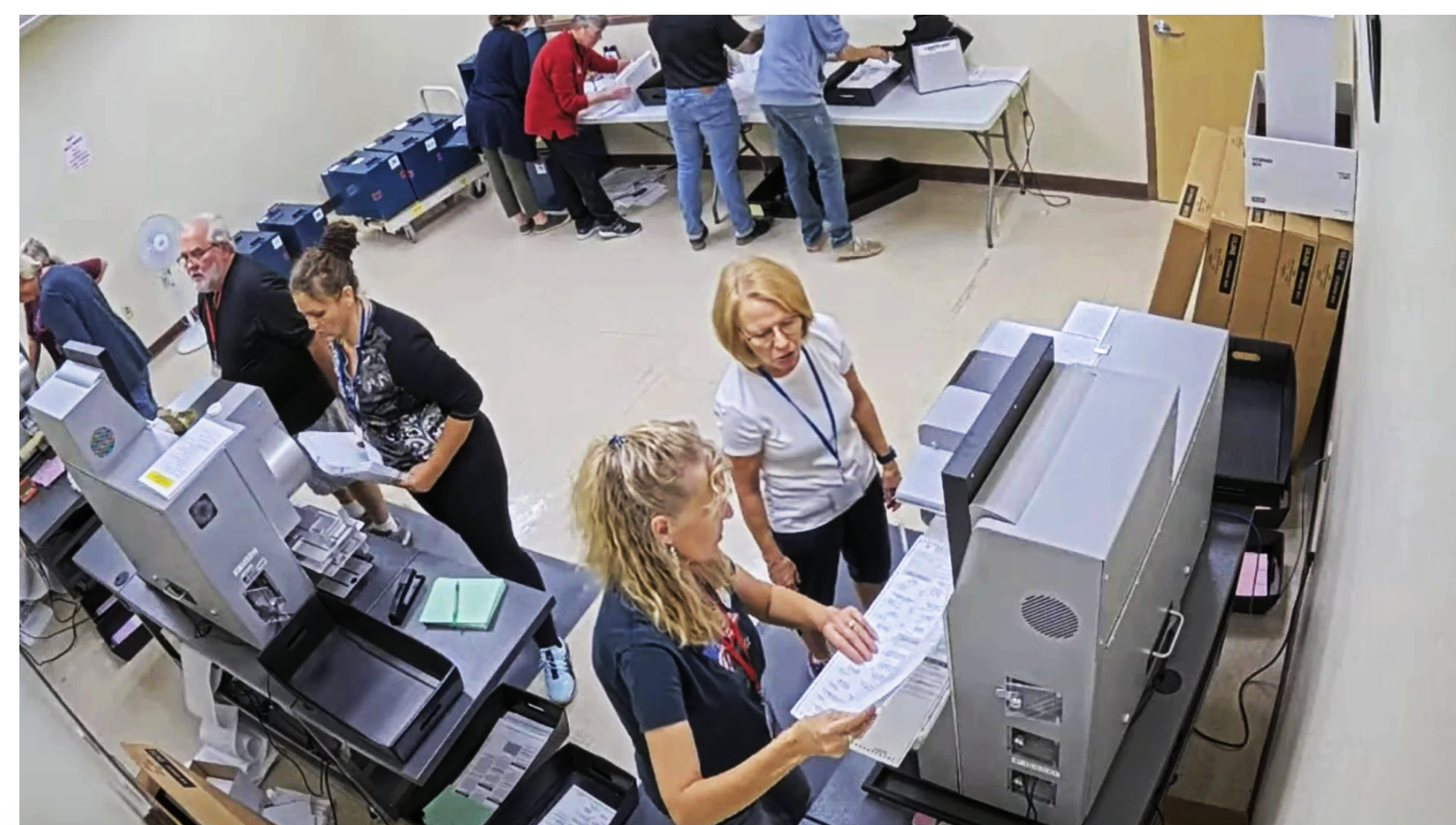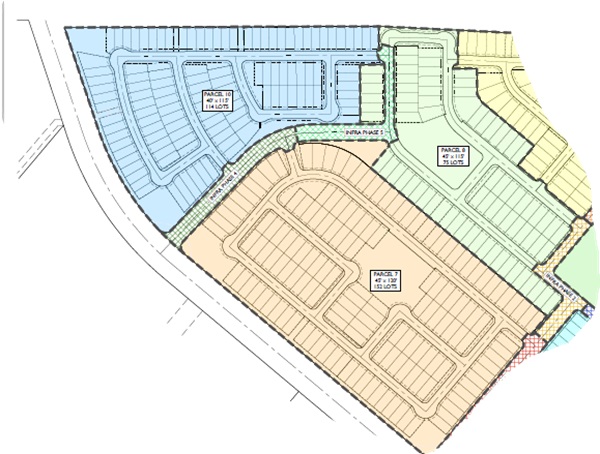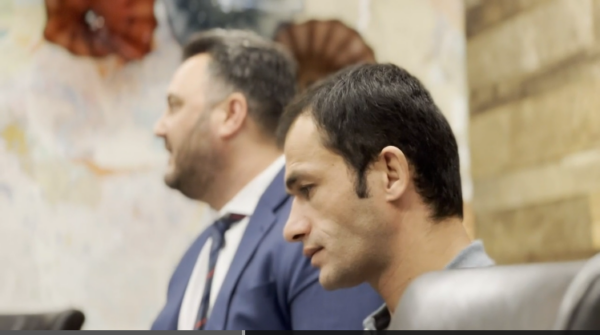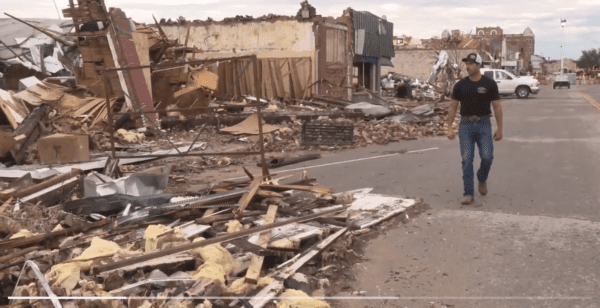BY: JEN FIFIELD/VOTEBEAT
Pinal County workers process ballots at election headquarters during the November 2022 midterm election. Screenshot via Pinal County election night livestream/YouTube
Coolidge, Arizona — “You can’t even imagine,” Geraldine Roll said, standing in the room where the mistakes were made. “You really, really can’t.”
Picture a dozen people, she said, weaving around one another in a room the size of a two-car garage, wheeling stacks of ballot boxes and carrying armloads of ballots to and from scanners set up on folding tables. It was loud. A machine shuffled ballots straight, shaking the tables. All night, the cramped space just kept getting hotter — 86, then 88 degrees, Roll said. More ballot boxes just kept arriving from polling locations. There was nowhere to put them, and with stacks covering the tables, it was hard to track them. Workers stacked boxes in the narrow hallway outside the door.
“It was a nightmare,” said Roll, who was in training to be Pinal County’s elections director at the time. “It was traumatic.”
Like trying to count ballots “in a mine,” said Supervisor Jeffrey McClure.
In the chaos, hundreds of ballots voters cast on Election Day went uncounted. Later, county officials would say a lack of experienced leaders, poor ballot tracking, and worker mistakes led to the errors, which were eventually corrected in a statewide recount.
Like many other counties across the U.S., Pinal County faces high elections staff turnover and a lack of clear, documented procedures, leading to mistakes. But here — more than most places — the county’s explosive growth has exacerbated the problem.
Pinal County, on the southeast edge of the Phoenix metro area, is the fastest-growing county in Arizona and one of the fastest-growing counties in the nation, according to a Votebeat analysis of U.S. Census data. The number of ballots moving through the elections center, a pair of buildings totaling 12,000 square feet in downtown Coolidge, has doubled since the county started conducting elections there less than a decade ago — from about 73,000 ballots in the 2014 midterm to about 146,000 in November. But the space, and the staff, has remained mostly the same.
There is simply not enough room for all those ballots. But there will be soon.
Construction is under way on a $29 million, 53,000-square-foot elections center in the nearby county seat of Florence, which will have more than enough room to keep voter registration, early voting, and Election Day activities under one roof. The space for tabulating ballots will increase from the garage-size, 416-square-foot room to a room that is more than triple the size. Workers processing early ballots will have three or four times more space. Tractor trailers carrying ballots from the post office will be able to unload them directly into a giant warehouse, instead of the county recorder guiding couriers back and forth from the street.
The plan is to move in by May, before the August 2024 primary. County leaders fear any delay — they say they can’t imagine conducting a presidential election in the current space.
Elections departments are building out not just here but across Arizona, one of the fastest-growing states in the country. More people means more ballots, equipment, and staff, driving the need for more space.
This summer, Maricopa County is starting to tear down walls and add storage racks to its elections center in downtown Phoenix to make more room for counting ballots, verifying voter signatures on early ballots, and storing equipment. Meanwhile, the county is preparing to start designing an entirely new elections center — one that could potentially open by 2026. And Yavapai County, the high desert area north of Phoenix that includes Prescott, is renovating to expand, too, while planning for new space in the future.
In the past few decades, Pinal County has grown as Maricopa County’s rapid growth sprawled past its southern border into the San Tan Valley, the city of Maricopa, and other booming Pinal County cities and towns. Pinal County is growing even faster than Maricopa County — nearly three times as fast — and lately it’s attracting large employers, not just retirees, as it has in the past. The new jobs and residents are reshaping the politics — registered independents just surpassed Republicans on the voter rolls, according to Recorder Dana Lewis.
It’s an expansive county, larger than Connecticut, so as you drive farther south, miles of undeveloped land still separate its many rural towns. But more and more, construction is coming. The population has more than tripled since 2000, to 460,000 today, and grew by more than 16,000 last year alone.
While many government offices are in Florence, elections operate out of an old public health complex on Main Street in Coolidge, a smaller town a dozen miles southwest down a two-lane highway. Elections moved here in 2014, after a fire started in the old elections center in Florence, destroying most of the county’s equipment.
The number of people in the elections department has remained at about five, even as the county grew. With such a small staff, and as two election directors left in quick succession, the strain led to problems that affected voters.
For the primary election last year, the county misprinted ballots and failed to order enough for polling places. An outside investigator recommended better written procedures but also said the county needed to expand its available space and staff as soon as possible.
The investigator wrote that the county didn’t have enough space for staging polling place setups or storing ballots or equipment. He recommended thousands more square feet for both, as well as a proper loading dock accessible by large trucks. He also recommended a building large enough to contain all activities related to elections, including voter registration, early voting, and Election Day preparation.
The county’s plans were accelerated in November, when more mistakes happened, in part due to the cramped quarters that led to disorganization while counting. A Votebeat investigation found that election officials had documented glaring errors with the results prior to the election being certified. The elections director at the time, Virginia Ross, accepted a $25,000 bonus and retired before the recount.
By March, the supervisors had designed the building, set aside money for the project, and construction had begun. The new center is being built on the site of the old county hospital, which was already demolished, and the old public defender’s building, which will be razed soon to make way for the parking lot.
The circumstances in the old building aren’t ideal, but Lewis is used to them.
Lewis was appointed county recorder to replace Ross after working in elections and early voting for years. Her early ballot processing building is just across an outdoor walkway from the elections building in Coolidge. Walking between the two buildings earlier this month, she laughed and said, “Oh my gosh” when asked how many times she thought she made the trip in November. Lewis lives in her high heels, she said, but not during an election.
Lewis’ team verifies signatures on early ballots in a modular building the county added on last year. It helped, but the recorder’s new space will be much larger, and include 10 times the room voters use for early in-person voting.
The county rolls early ballot boxes in locked cages between the buildings once voter signatures on them are verified. Lewis has stories of lugging the cages between the buildings in the rain, in the middle of the night — whatever it takes to get them in and counted.
The county now has nearly a half-million people, but the elections staff in Pinal still operates in the hands-on, everyone-in way that a small town might. Lewis said she likes it that way. But it is a lot, the leaders admit, and as the county continues to grow and add staff, it is already changing.
Roll, now elections director, is attempting this summer to bounce back from the county’s election woes by clearly documenting proper procedures, hiring talented staff, and training them well. “It’s all from the ground, up,” she said.
Counties are building while facing questions about the security of elections and the elections process, so transparency is top of mind.
In Pinal’s election complex now, there’s a small window that allows the public to observe activity in the tabulation room from the adjacent hallway. But there’s little room for anyone to stand watch there as ballot boxes are being wheeled around and stored.
In the new space, there will be a near-360-degree public observation room that the county is calling its “fishbowl,” with windows into three separate work spaces. The public lobby will allow observers to watch workers verifying signatures on early ballots, removing ballots from envelopes, and tabulating ballots. Video cameras in the room will show activities in other areas of the building.
“What’s so cool is you get to see the whole process,” Roll said.
And it’s more secure. The ballots won’t be stored in hallways on election night but behind locked doors that only certain staff can enter. There will be a public bathroom accessible from the observation room, so there will be no need to take guests into secure spaces. The complex will be surrounded by a gate, and the parking lot will also be enclosed, and there will be bollards around the perimeter.
Lewis said staff will feel much more secure in this “envelope of security.”
The county is looking at what Maricopa County does to protect its building and staff as it considers projections showing Pinal will continue to grow, and increasingly be politically purple — which could lead to more conflict. The blueprints show room to add more workspace inside the building as needed, and the large lot the county owns could allow for additions.
By 2050, this old farming and mining county is expecting to hit 1 million people.
“How do you build for the future?” McClure asks.
Jen Fifield is a reporter for Votebeat based in Arizona. Contact Jen at jfifield@votebeat.org.
Votebeat is a nonprofit news organization covering local election integrity and voting access. Sign up for their newsletters here












